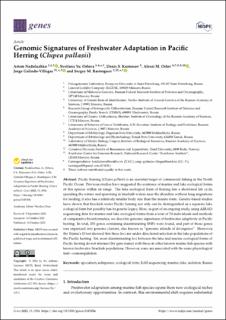Genomic signatures of freshwater adaptation in Pacific herring (Clupea pallasii)
Peer reviewed, Journal article
Published version
Permanent lenke
https://hdl.handle.net/11250/3026633Utgivelsesdato
2022Metadata
Vis full innførselSamlinger
Originalversjon
Nedoluzhko, A., Orlova, S., Sharko, F., Galindo-Villegas, J. & Rastorguev, S. (2022). Genomic signatures of freshwater adaptation in Pacific herring (Clupea pallasii). Genes, 13: 1856. doi: 10.3390/genes13101856Sammendrag
Pacific herring (Clupea pallasii) is an essential target of commercial fishing in the North Pacific Ocean. Previous studies have suggested the existence of marine and lake ecological forms of this species within its range. The lake ecological form of herring has a shortened life cycle, spending the winter and spawning in brackish waters near the shoreline without long migrations for feed-ing; it also has a relatively smaller body size than the marine form. Genetic-based studies have shown that brackish water Pacific herring not only can be distinguished as a separate lake eco-logical form but possibly has its genetic legacy. Here, as part of an ongoing study, using ddRAD-sequencing data for marine and lake ecological forms from a total of 54 individuals and methods of comparative bioinformatics, we describe genomic signatures of freshwater adaptivity in Pacific herring. In total, 253 genes containing discriminating SNPs were found, and part of those genes was organized into genome clusters, also known as “genomic islands of divergence”. Moreover, the Tajima’s D test showed that these loci are under directional selection in the lake populations of the Pacific herring. Yet, most discriminating loci between the lake and marine eco-logical forms of Pacific herring do not intersect (by gene name) with those in other known marine fish species with known freshwater/brackish populations. However, some are associated with the same physiological trait—osmoregulation.

